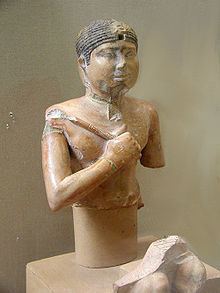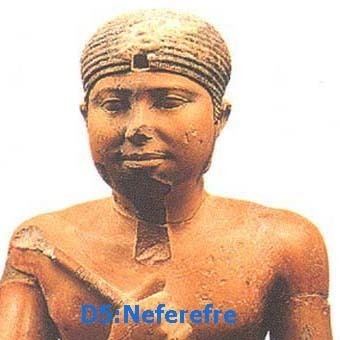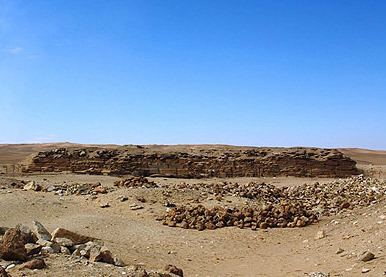Died 2461 BC | ||
 | ||
Place of burial Pyramid of Neferefre, Egypt Children Menkauhor Kaiu, Shepseskare Parents Neferirkare Kakai, Khentkaus II Similar | ||
Pyramid of neferefre egyptian monuments the ancient egypt site
Neferefre Isi (also known as Raneferef, Ranefer and in Greek as Cherês, Χέρης) was an Ancient Egyptian pharaoh, likely the fourth but also possibly the fifth ruler of the Fifth Dynasty during the Old Kingdom period. He was very likely the eldest son of pharaoh Neferirkare Kakai and queen Khentkaus II, known as prince Ranefer before he ascended the throne.
Contents
- Pyramid of neferefre egyptian monuments the ancient egypt site
- Khentakawess iii 4500 year old tomb in egypt pharaoh neferefre s wife egyptian religion is black
- Parents and siblings
- Consort and children
- Accession to the throne
- Reign duration
- Pyramid
- Mortuary temple
- Mummy of Neferefre
- Sun temple Hotep Re
- Pyramid of Neferirkare Kakai
- References

Khentakawess iii 4500 year old tomb in egypt pharaoh neferefre s wife egyptian religion is black
Parents and siblings

Neferefre was, in all likeliness, the eldest son of his predecessor pharaoh Neferirkare Kakai with queen Khentkaus II. This is shown by a relief on a limestone slab depicting Neferirkare and his wife Khentkaus with "the king's eldest son Ranefer", a name identical with some variants of Neferefre's own. This indicates that Ranefer was Neferefre's name when he was still only a crown prince, that is before his accession to the throne.

Neferirkare and Khentkaus had at least another son, the future king Nyuserre Ini. In addition, since the relation between Shepseskare and Neferefre remains uncertain, it is possible that the two were brothers too, as suggested by the Egyptologist Silke Roth, although other hypotheses on the matter have been proposed:Miroslav Verner sees Shepseskare as a son of Sahure and hence Neferefre's uncle, while Jaromír Krejčí believes Shepseskare was Neferefre's son. Finally, yet another brother, possibly younger than both Neferefre and Nyuserre has also been proposed: Iryenre, a prince Iry-pat whose filiation is suggested by the fact that his funerary cult was associated with that of his mother, both having taken place in the temple of Khentkaus II.
Consort and children

Until 2014, no consort of Neferefre was known. Late in this year however, the mastaba of Khentkaus III was discovered by archaeologists from the Czech Institute of Egyptology working in Abusir, south east of Neferefre's pyramid. The location and date of the tomb as well as inscriptions found in it strongly suggest that Khentkaus III was Neferefre's queen. Indeed, not only was Khentkaus III likely buried during the few decades following Neferefre's reign, but her mastaba is also in close proximity to his pyramid, and she bore the title of "King's wife", proving that she was a queen.

In addition, Khentkaus III was also called "King's mother" by inscriptions in her tomb, indicating that her son had become pharaoh. Since Neferefre's second successor Nyuserre Ini is known to have been his brother rather than his son, and since Khentkaus III was likely buried during Nyuserre's reign, as indicated by mud seals, this only leaves either Neferefre's ephemeral successor Shepseskare or Nyuserre's successor Menkauhor Kaiu as possibilities. There is an ongoing debate in Egyptology concerning these two alternatives, with Verner positing that Shepseskare was an uncle of Neferefre and thus that Menkauhor Kaiu was Neferefre's son and Krejčí viewing the opposite hypothesis, that Shepseskare was Neferefre's son with Khentkaus III, as more probable.

Two further sons of Neferefre and Khentkaus III have been proposed by Verner: the king's son Nakhtsare, whose filiation is supported by the general date and location of his tomb, and Kakaibaef, a member of the elite buried in Abusir. Krejčí notes the lack of king's son title in relation to Kakaibaef however, thereby emphasizing the conjectural nature of Verner's assertion.
Accession to the throne
Two competing hypotheses exist in Egyptology to describe the succession of events running from the death of Neferirkare Kakai, third king of the Fifth Dynasty, to the coronation of Nyuserre Ini, sixth ruler of the dynasty. Relying on historical sources, most notably the Saqqara king list and Manetho's Aegyptiaca, where Neferefre is said to have succeeded Shepseskare, many Egyptologists such as Jürgen von Beckerath and Hartwig Altenmüller have traditionally believed that the the following royal succession took place: Neferirkare Kakai → Shepseskare → Neferefre Isi → Nyuserre Ini. In this scenario, Neferefre would be the father of Nyuserre, who would have become pharaoh after his father's unexpected death.
This view was challenged at the turn of the millenium, most notably by Verner, who is responsible for the archaeological excavations of the Fifth Dynasty royal necropolis of Abusir since 1976. Firstly, there is the relief, mentionned earlier, showing that Neferefre was in all likeliness Neferirkare's eldest son.
Secondly, excavations of Neferefre's pyramid have yielded his mummy, which showed that he was 18 to 20 years old at the death of Neferirkare. Consequently, as the previous king's eldest son, in his late teens to early twenties, Neferefre was in optimal position to ascend the throne. Positing that Shepseskare reigned between Neferefre and his father would thus require an explanation as to why and how Shepseskare's claim to the throne could have been stronger than Neferefre's.
Thirdly, archaeological evidences indicate that Shepseskare most likely reigned for only a few weeks to a few months at the most rather than seven years as credited to him in the Aegyptiaca, an hypothesis already supported by Nicolas Grimal as early as 1988. Indeed, Shepseskare is the least known Fifth Dynasty king, with only two seals and a few seal impressions bearing his name known as of 2017, a paucity of attestations suggesting a very short reign. This is also supported by the state of Shepseskare's unfinished pyramid, which "was interrupted [and] corresponds to the work of several weeks, perhaps no more than one or two months".
Fourthly, archaeological evidence also favors dating Shepseskare's reign to after Neferefre's. Some of the few seal impressions bearing Shepseskare's name have been discovered in the oldest part of Neferefre's mortuary temple, which was not built "until Neferefre's death". This seems to indicate that Shepseskare made offerings for the funerary cult of Neferefre, who must therefore have reigned before him. Another argument concerns the alignment of pyramids of Sahure, Neferirkare Kakai and Neferefre: they form a line pointing to Heliopolis, just as the three pyramids of Giza do. In contrast, Shepseskare's unfinished pyramid does not fall on the line to Heliopolis, which strongly suggests that Neferefre's pyramid had already been in place when Shepseskare started to build his. Lastly, while Shepseskare is noted as the immediate predecessor of Neferefre in the Saqqara king list, Verner notes that "this slight discrepancy can be attributed to the [political] disorders of the time and its dynastic disputes." Verner's arguments have convinced a number of Egyptologists, including Darrell Baker and Erik Hornung.
Reign duration
While Neferefre is given a reign of some twenty years in epitomes of Manetho's Aegyptiaca, the current academic view is that this number is an overestimation of his true reign length, which must have been shorter. Before the results of the extensive excavations in Abusir were fully published, Egyptologists following the traditional succession hypothesis credited Neferefre with around a decade of rule, based on the paucity of attestations contemporaneous with his reign. For exemple, von Beckerath and Winfried Barta gave him with 11 and 10 years on the throne, respectively. This view now has few supporters.
Indeed, since then, Verner has set forth the hypothesis of a reign of no more than two years. His conclusion is based on archaeological evidences: the completely unfinished state of his intended pyramid, and the general paucity of documents datable to his rule. Verner writes on the subject that:
The shape of the tomb of Neferefra...as well as a number of other archaeological finds clearly indicate that the construction of the king's funerary monument was interrupted, owing to the unexpected early death of the king. The plan of the unfinished building had to be basically changed and a decision was taken to hastily convert the unfinished pyramid, (of which only the incomplete lowest step of the core was built), into a "square-shaped mastaba" or, more precisely, a stylized primeval hill. At the moment of the king's death neither the burial apartment was built, nor was the foundation of the mortuary temple laid.
Furthermore, two historical sources comform with the hypothesis of a short reign: the mason's inscription in Neferefre's pyramid was discovered "at about two thirds of the height of the extant core of the monument" and likely refers to Neferefre's first or second year on the throne; and the Turin list of kings, written under Ramses II, credits Neferefre with one to two years of rule.
The combination of archaeological and historical evidences led to the consensus that Neferefre's reign lasted "not longer than about two years".
A significant cache of administrative papyri–comparable in size to the Abusir Papyri found in the temple of Neferirkare–was discovered at Abusir by a 1982 University of Prague Egyptological Institute excavation from a storeroom of his mortuary temple.
Pyramid
Neferefre started the construction of a pyramid for himself in the royal necropolis of Abusir, where his father and grandfather had built their own pyramids. It was known to the Ancient Egyptians as Netjeribau Raneferef meaning "The bas of Neferefre are divine".
Planned with a square base of 108 m (354 ft), the pyramid of Neferefre was to be larger than those of Userkaf and Sahure, but smaller than that of his father Neferirkare. At the unexpected death of Neferefre, only its lower courses had been completed. Subsequently, Nyuserre hastily completed the monument by filling its central part with clay so as to give it the form of a mound. Although it may share the same resemblance to a mastaba tomb, it is not situated north-south, and it is not rectangular in shape.
Known today as the "Unfinished Pyramid" and stands 7 m (23 ft) high. Similarly to other sites of other Ancient Egyptian pyramids, the burial site of Neferefre contains more than one pyramid, and his lines up the three pyramids, similarly to the Great Pyramids. While exploring ruins of the mortuary complex, a Czech archaeological expedition discovered papyri of temple accounts, statues of the king, decorated plates and many seal prints.
Mortuary temple
The building of the temple in which the funerary cult of the deceased king was to take place had not even started when Neferefe died. His ephemeral successor Shespeskare might therefore have built a small stone chapel where the temple had been planned, chapel which was finished by Nyuserre. In addition Nyuserre built a proper mortuary temple for his brother, extending over the whole 65 m (213 ft) length of the pyramid side. The temple was however built of mudbrick and wood, comprising notably the earliest hypostyle hall of Ancient Egypt, its roof supported by wooden columns, which was likely inspired by the royal palaces of the time.
This hall housed a large wooden statue of the deceased king as well as statue of prisoners of war. Magazines for the offerings were located the north of the hall and, east of it, was the "Sanctuary of the Knife" where animals were ritually slaughtered. A column courtyard completed the temple entrance, adorned with two stone columns and 24 wooden ones.
Mummy of Neferefre
Fragments of mummy wrappings and cartonnage, as well as scattered pieces of human remains were discovered on the east side of the burial chamber of the pyramid. The remains amounted to a left hand, a left clavicle still covered with skin, fragments of skin likely from the forehead, upper eyelid and the left foot and a few bones. These remains were located in the same archaeological layer as broken pieces from a red granite sarcophagus as well as what remained of the funerary equipment of the king, hinting that they could indeed belong to Neferefre. This was further confirmed by subsequent studies of the embalming techniques used on the mummy, found to be compatible with an Old Kingdom date, and finally by radiocarbon dating, which yielded a 2628–2393 BC interval for the human remains in close correspondence with estimated dates for the Fifth Dynasty. Thus, Neferefre is, with Djedkare Isesi, one of the very few Old Kingdom pharaohs whose mummy has been identified with certainty.
A bioarchaeological analysis of Neferefre's remains revealed that the king did not partake in strenuous works, died in his early twenties at between 20 and 23 years old and that he may have stood 167 cm (66 in) to 169 cm (67 in) in height.
The remains of a second individual were discovered in the burial chamber, but those proved to belong an individual from the late Medieval era, who likely lived during the 14th century AD. He had simply been laid on rags and covered with sand for his burial.
Sun temple Hotep-Re
Following a tradition established by Userkaf, founder of the Fifth Dynasty, Neferefre planned or built a temple to the sun god Ra. Called Hotep-Re by the Ancient Egyptians, meaning "Ra is content", the temple has not yet been located but is likely to be in the vicinity of Neferefre's pyramid in Abusir. It is known solely from inscriptions discovered in the mastaba of Ti in Saqqara, where it is mentioned four times. Ti served has an administration official in the temple, as well as in the sun temples of Sahure, Neferirkare and Nyuserre.
Given Neferefre's very short reign, the lack of attestations of the Hotep-Re beyond the mastaba of Ti, as well as the lack of priests having served in the temple, Verner proposes that the temple was likely never completed and thus never functioned as such. Rather it might have been integrated to or its materials reused for the Shesepibre, the sun temple built by Neferefre's likely younger brother, Nyuserre.
Pyramid of Neferirkare Kakai
When he ascended the throne, Neferefre faced the task of completing the pyramid of his father which, with a square base side of 105 m (344 ft) and a height of 72 m (236 ft), is the largest built during the Fifth Dynasty. Although well underway at the death of Neferirkare, the pyramid was lacking its external limestone cladding and the accompanying mortuary temple still had to be built. Neferefre, thus started to cover the pyramid surface with limestone and build the foundation of a stone temple on the pyramid eastern side. His plans were cut short by his death and the duty of finishing the monument fell on Nyuserre's shoulders, who abandoned the task of covering the pyramid face and rather concentrated on building the mortuary temple in bricks and wood.
